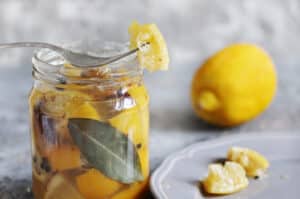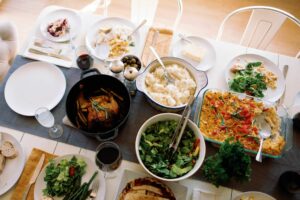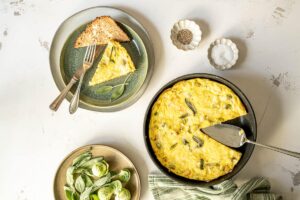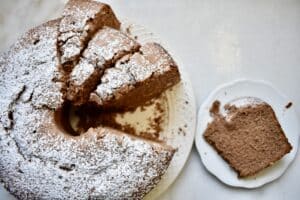Dinner Table Rating Not Applicable
1 thumb per family member
Cook’s Rating
Accessibility of ingredients, ease of preparation, and affordability
I confess to already having some experience with making preserves and such. We have a very prolific plum tree that has driven me to days (weeks?) on end of canning plum chutney, plum sauce, plum butter, plum jam and plum conserve. So the idea of making preserved lemons was really more appealing to me than intimidating.
I arrived at this recipe because it’s an ingredient in one of the main course recipes I want to make, Moroccan Style Chicken (tune in next week for that one!) These lemons were super-easy and very rewarding. The hardest part has been waiting two weeks for them to “preserve” themselves.
Sally’s recipes for preserves all rely on fermentation as a means of preservation. Fermentation uses the lactobacilli bacteria (present on the surface of all living things) to convert the starches and sugars in fruits and vegetables into lactic acid. The lactic acid is a natural preservative that inhibits putrefying bacteria. This was a major method of food preservation in practically every society up until about a century ago. The lactobacilli, in addition to preserving the fruit, also enhances the digestibility and the availability of nutrients in the fruit. These are the bacteria touted on all the yogurt labels these days that promote the growth of healthy flora in your intestines.
Preserved Lemons (Nourishing Traditions, page 109)
Ingredients
- 5 organic lemons preferably thin-skinned
- 3 tablespoons sea salt
- 3 cinnamon sticks broken up
- 2 tablespoons whey (Nourishing Traditions, page 87)
- juice of 2 lemons
1. Wash lemons well, slice thinly and cut slices into quarters.
Sally doesn’t say what to do with the seeds, so I took them out. I don’t think it would hurt to leave them in if you’re not feeling as fastidious as I was. Out of curiosity I consulted my Ball canning and preserving book to compare Sally’s recipe to theirs. If the idea of all that slicing and quartering doesn’t appeal to you, the Ball method just has you quartering the lemon down the sides, but leaving the bottom intact. I may try it this way next time, just for giggles.
2. Toss lemon slices in a bowl with salt and cinnamon sticks.
The Ball recipe also adds bay leaves and peppercorns, which sound like a delicious addition. Don’t be put off by the salt. Salt inhibits the growth of bad bacteria until the lactobacilli are prolific enough to do the job. Think of it as kindling for the fuel.
3. Place in a quart-sized, wide-mouth mason jar and press down lightly with a wooden pounder or a meat hammer. Mix lemon juice with whey and add to jar, pressing down so that the liquid completely covers the lemons. Lemons should be at least 1 inch below the top of the jar.
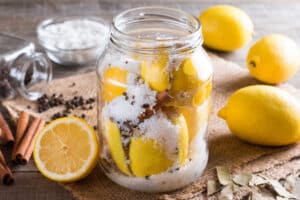
The addition of whey is unique to Sally’s recipes. She says the use of whey will reduce the time needed for sufficient lactic acid to produced to ensure preservation, since it is rich in lactobacilli itself. While fermentation is never quite predictable, using whey will give you a more consistent product.
The amount of juice I ended up with didn’t quite cover the lemons. I wasn’t sure if they were supposed to be completely submerged or not, but to be safe I doubled the amount of juice and whey. My fruit still floated to the top, but it seemed to not effect the process. Be sure to leave some space between the top of your fruit and the top of your jar (also called “headspace”) since the fruit and the liquid will expand slightly during fermentation.
4. Cover tightly and keep at room temperature for up to 2 weeks, turning jar once a day, before transferring to cold storage.
I kept my jar in a cool, dark corner on my countertop where I would see it and remember to “turn” it. I was a little confused by what was meant by “turn”. In the end I decided it meant to turn it, top to bottom, so that the contents would mix. So one day it would be standing on its top, and the next day it would be standing on its bottom, if that makes sense.
Once you’ve sealed your jar, resist the temptation to open it up and check on it. Lacto-fermentation is an anaerobic process (meaning it takes place “without oxygen” for anyone struggling to remember their 10th grade biology). The presence of oxygen, once fermentation has begun, can ruin your final product, which would be very sad.
When I took the lid off of this baby after two weeks to sample the result, the scent was like a pure Mediterranean summer and truly amazing. I didn’t give this recipe a Dinner Table Rating, since it’s not really meant to be eaten on its own, but is more of an ingredient. I’m giving it all three stars for a Cook’s Rating.
I’ve had more than one comment lately questioning whether recipes from Nourishing Traditions are actually physically possible in a budget-conscious, busy home. So far, I haven’t found these recipes to be time- or labor-prohibitive. They haven’t required me to alter my schedule or spend inordinate amounts of time in the kitchen. Some recipes call for ingredients that can be pricey, depending on where you live. But there are many other recipes that call for simple ingredients that you can buy at any grocery store. They do require planning, which should already be a part of any budget-conscious, busy household.
As proof that I am just as budget-conscious and busy as the next mama, I offer this photo, which was taken while I was trying to snap a photo of some macerated lemons:
Yes, that is a pants-less baby with applesauce in her hair, chewing on a dirty dishrag. But doesn’t she look happy?!
Preserved Lemons
Source: Nourishing Traditions by Sally Fallon
Course: Fermented and Cultured Food
Serves:
Ingredients
- 5 organic lemons preferably thin-skinned
- 3 tablespoons sea salt
- 3 cinnamon sticks broken up
- 2 tablespoons whey
- juice of 2 lemons
Directions
- Instructions on page 109 in Nourishing Traditions



